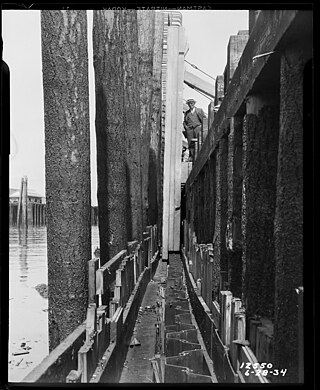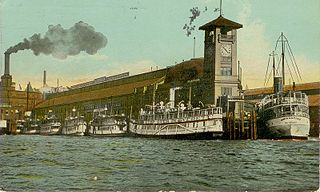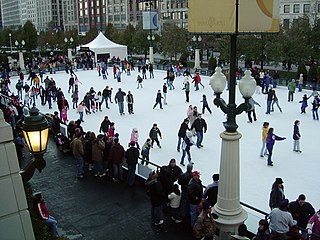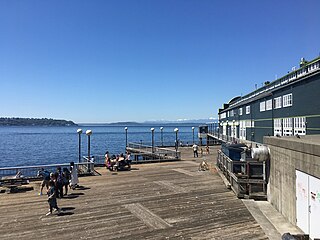
Navy Pier is a 3,300-foot-long (1,010 m) pier on the shoreline of Lake Michigan, located in the Streeterville neighborhood of the Near North Side community area in Chicago, Illinois, United States. Navy Pier encompasses over 50 acres (20 ha) of parks, gardens, shops, restaurants, family attractions and exhibition facilities and is one of the top destinations in the Midwestern United States, drawing over nine million visitors annually. It is one of the most visited attractions in the entire Midwest and is Chicago's second-most visited tourist attraction.

Elliott Bay is a part of the Central Basin region of Puget Sound. It is in the U.S. state of Washington, extending southeastward between West Point in the north and Alki Point in the south. Seattle was founded on this body of water in the 1850s and has since grown to encompass it completely. The waterway it provides to the Pacific Ocean has served as a key element of the city's economy, enabling the Port of Seattle to become one of the busiest ports in the United States.

State Route 99 (SR 99), also known as the Pacific Highway, is a state highway in the Seattle metropolitan area, part of the U.S. state of Washington. It runs 49 miles (79 km) from Fife in the south to Everett in the north, passing through the cities of Federal Way, SeaTac, Seattle, Shoreline, and Lynnwood. The route primarily follows arterial streets, including Aurora Avenue, and has several freeway segments, including the tolled SR 99 Tunnel in Downtown Seattle. SR 99 was officially named the William P. Stewart Memorial Highway by the state legislature in 2016, after a campaign to replace an unofficial moniker honoring Confederate president Jefferson Davis.

The Port of Seattle is a government agency overseeing the seaport of Seattle, Washington, United States as well as Seattle–Tacoma International Airport. With a portfolio of properties ranging from parks and waterfront real estate, to one of the largest airports and container terminals on the West Coast, the Port of Seattle is one of the Pacific Northwest's leading economic engines.

The Alaskan Way Viaduct was an elevated freeway in Seattle, Washington, United States, that carried a section of State Route 99. The double-decked freeway ran north–south along the city's waterfront for 2.2 miles (3.5 km), east of Alaskan Way and Elliott Bay, and traveled between the West Seattle Freeway in SoDo and the Battery Street Tunnel in Belltown.

State Route 519 (SR 519) is a state highway in Seattle, Washington, United States. It connects Interstate 90 (I-90) to the Port of Seattle and Colman Dock, which serves as the terminus of two ferry routes. The highway travels along city streets, including two named for Seattle Mariners personalities: Edgar Martinez Drive and Dave Niehaus Way, as well as Alaskan Way. SR 519 was established in 1991 on preexisting streets that were first built in the early 20th century. State projects moved the southern terminus of SR 519 in 2010 to its current location and temporarily rerouted it during demolition of the Alaskan Way Viaduct.

The Waterfront Streetcar, officially the George Benson Waterfront Streetcar Line, was a heritage streetcar line run by King County Metro in Seattle, Washington, United States. It traveled for 1.6-mile (2.6 km) along Alaskan Way on the city's waterfront facing Elliott Bay, under the Alaskan Way Viaduct. The Waterfront Streetcar used a fleet of five W2 trams from Melbourne, Australia.

The Alaskan Way Seawall is a seawall which runs for approximately 7,166 feet (2,184 m) along the Elliott Bay waterfront southwest of downtown Seattle from Bay Street to S. Washington Street. The seawall is being rebuilt in the 2010s as part of a waterfront redevelopment megaproject estimated to cost over $1 billion.

The Port of San Francisco is a semi-independent organization that oversees the port facilities at San Francisco, California, United States. It is run by a five-member commission, appointed by the Mayor and approved by the Board of Supervisors. The Port is responsible for managing the larger waterfront area that extends from the anchorage of the Golden Gate Bridge, along the Marina district, all the way around the north and east shores of the city of San Francisco including Fisherman's Wharf and the Embarcadero, and southward to the city line just beyond Candlestick Point. In 1968 the State of California, via the California State Lands Commission for the State-operated San Francisco Port Authority, transferred its responsibilities for the Harbor of San Francisco waterfront to the City and County of San Francisco / San Francisco Harbor Commission through the Burton Act AB2649. All eligible State port authority employees had the option to become employees of the City and County of San Francisco to maintain consistent operation of the Port of San Francisco.

The Puget Sound mosquito fleet was a multitude of private transportation companies running smaller passenger and freight boats on Puget Sound and nearby waterways and rivers. This large group of steamers and sternwheelers plied the waters of Puget Sound, stopping at every waterfront dock. The historical period defining the beginning and end of the mosquito fleet is ambiguous, but the peak of activity occurred between the First and Second World Wars.

Tourism in Chicago draws on the city's status as a "world-class destination known for its impressive architecture, first-rate museums, brilliant chefs" and wide variety of neighborhood attractions.

Alaskan Way, originally Railroad Avenue, is a street in Seattle, Washington, that runs along the Elliott Bay waterfront from just north of S. Holgate Street in the Industrial District—south of which it becomes East Marginal Way S.— to Broad Street in Belltown, north of which is Myrtle Edwards Park and the Olympic Sculpture Park. The right-of-way continues northwest through the park, just west of the BNSF Railway mainline, and the roadway picks up again for a few blocks at Smith Cove. It follows a route known in the late 19th century as the "Ram's Horn" because of its shape. The street gave its name to the Alaskan Way Viaduct, which until 2019 carried Washington State Route 99 through Downtown Seattle.

The Central Waterfront of Seattle, Washington, United States, is the most urbanized portion of the Elliott Bay shore. It runs from the Pioneer Square shore roughly northwest past Downtown Seattle and Belltown, ending at the Broad Street site of the Olympic Sculpture Park.

Waterfront Park is a public park on the Central Waterfront, Downtown, Seattle, Washington, USA. Designed by the Bumgardner Partnership and consultants, it was constructed on the site of the former Schwabacher Wharf.

The State Route 99 tunnel, also known as the Alaskan Way Viaduct replacement tunnel, is a bored highway tunnel in the city of Seattle, Washington, United States. The 2-mile (3.2 km), double-decker tunnel carries a section of State Route 99 (SR 99) under Downtown Seattle from SoDo in the south to South Lake Union in the north.

Pier 54 is a tourist pier in Seattle, Washington. Previously an active shipping pier and warehouse, Pier 54 was originally known as Pier 3 until it was renumbered during World War II. This pier was also known as Galbraith dock and the Galbraith Bacon dock. Because of the large number of smaller local steamships, generally built of wood, that used the pier up until the 1930s, the pier was also known as the “Mosquito Fleet dock”.

The Seattle Great Wheel is a 53-meter tall giant Ferris wheel at Pier 57 on Elliott Bay in Seattle, Washington. At an overall height of 175 feet (53.3 m), it was the tallest Ferris wheel on the West Coast of the United States when it opened in June 2012.

Fisherman's Restaurant and Bar is a seafood restaurant in Seattle, in the U.S. state of Washington.


















